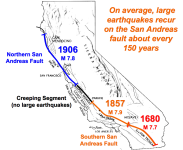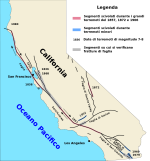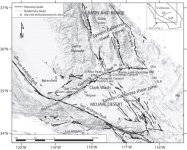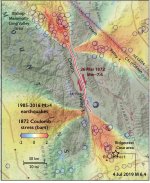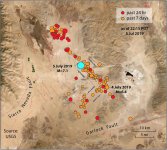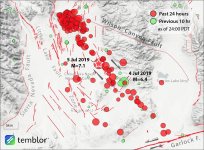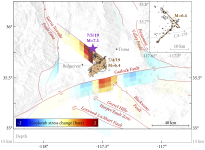Cel mai puternic cutremur produs in California a fost generat de ruperea unui segment sudic masiv al faliei San Andreas la 9 ianuarie 1857: cutremurul de la Fort Tejon, cotat cu o magnitudine Mw 7,9. Acest mare cutremur a fost, se pare, cam de 2-3 ori mai puternic decat seismul de la San Francisco de la 18 aprilie 1906 (care a rupt un segment nordic al faliei San Andreas). Ceea ce asteapta de fapt americanii pe falia San Andreas este un mare cutremur in partea sudica a faliei SA, deci ceva in genul cutremurului din 1857. Cutremurul din 1857 a rupt un segment sudic al faliei SA, cu lungimea de aprox. 350 km, de la Parkfield la Wrightwood. Desi epicentrul a fost localizat in zona Parkfield, el este referit sub numele de "cutremurul de la Fort Tejon" deoarece aceasta a fost localitatea in care s-au inregistrat cele mai mari distrugeri.
Dupa marele cutremur din 1857, in zona Parkfield s-au produs numai cutremure cu magnitudini in jur de 6,0, la intervale aproape standard de 15-32 ani: 1881, 1901, 1922, 1934, 1966. S-a estimat o perioada medie de revenire de cca. 22 de ani. Dupa seismul din 1966, urmatorul cutremur cu magnitudinea 6 pe segmentul Parkfield al faliei SA era asteptat in jurul anului 1988 (an de referinta), cu o marja de +/-5 ani. Experimentul Parkfield a constat intr-o prognoza pe termen lung combinata cu monitorizarea in timp real a unor parametri geofizici si a deformarilor crustei terestre, a temperaturii apelor freatice in zona faliei etc. Esec total, cutremurul Parkfield mult-asteptat de americani in jurul anului 1988 nu a venit in fereastra de timp asteptata. Cutremurul a venit pana la urma, dar mult mai tarziu decat il asteptau seismologii: la 28 septembrie 2004! De ce oare ? Poate ca si din cauza cutremurului de la Coalinga din 2 mai 1983, care a impiedicat, se pare, propagarea tensiunilor si concentrarea acestora pe segmentul Parkfield al faliei SA. Acum segmentul Parkfield se apropie de expirarea intervalului standard de pauza, practic incepe o fereastra de timp cu mare probabilitate pentru urmatorul cutremur cu magnitudinea 6. Vine sau nu vine ? Vine in urmatorii 5 ani sau se repeta istoria si iar intarzie cu 10-15 ani ? Si ce l-ar putea intarzia ? Seismologii acorda un mare interes cutremurelor de la Parkfield, pentru ca se crede ca unul dintre urmatoarele cutremure de pe acest segment al faliei SA ar putea declansa un mare cutremur in Sudul Californiei, prin ruperea masiva a partii sudice a faliei SA, deci cu un eveniment in genul celui din 1857. Deci vine sau nu vine cutremur la Parkfield, pe segment sudic al faliei San Andreas, in urmatorii ani ?
